Polymer Stabilized Liquid Crystal Smart Window with Flexible Substrates Based on Low-Temperature Treatment of Polyamide Acid Technology
Abstract
:1. Introduction
2. Experimental Section
2.1. Materials
2.2. Methods
2.2.1. Preparation of LC Cells
2.2.2. Measurement
3. Results and Discussion
3.1. Low Temperature Treatment of PAA
3.2. PSLC with Low-Temperature Treated PAA on Glass
3.2.1. Homeotropic Alignment
3.2.2. Electro-Optic Properties
3.3. PSLC with Low-Temperature Treated PAA on a Flexible Substrate
4. Conclusions
Supplementary Materials
Author Contributions
Acknowledgments
Conflicts of Interest
References
- Rezaei, S.D.; Shannigrahi, S.; Ramakrishna, S. A review of conventional, advanced, and smart glazing technologies and materials for improving indoor environment. Sol. Energy Mater. Sol. Cells 2017, 159, 26–51. [Google Scholar] [CrossRef]
- Baetens, R.; Petter, B.; Gustavsen, A. Properties, requirements and possibilities of smart windows for dynamic daylight and solar energy control in buildings: A state-of-the-art review. Sol. Energy Mater. Sol. Cells 2010, 94, 87–105. [Google Scholar] [CrossRef]
- Lee, E.S.; Yazdanian, M.; Selkowitz, S.E. The Energy-Savings Potential of Electrochromic Windows in the US Commercial Buildings Sector. California 2004, 33, 1–42. [Google Scholar]
- 4. Kamalisarvestani, M.; Saidur, R.; Mekhilef, S.; Javadi, F.S. Performance, materials and coating technologies of thermochromic thin films on smart windows. Renew. Sustain. Energy Rev. 2013, 26, 353–364. [Google Scholar] [CrossRef]
- Wong, K.V.; Chan, R. Smart Glass and Its Potential in Energy Savings. Energy Resour. Technol. 2013, 136, 4768. [Google Scholar] [CrossRef]
- Fridley, D. Estimating Total Energy Consumption and Emissions of China’s Commercial and Office Buildings. Available online: http://escholarship.org/uc/item/81t4h0q1.pdf. (accessed on 23 April 2019).
- Meng, C.; Tseng, M.C.; Tang, S.T.; Zhao, C.X.; Yeung, S.Y.; Kwok, H.S. Normally transparent smart window with haze enhancement via inhomogeneous alignment surface. Liq. Cryst. 2019, 49, 8764. [Google Scholar] [CrossRef]
- Baliyan, V.K.; Jeong, K.-U.; Kang, S.-W. Dichroic-dye-doped short pitch cholesteric liquid crystals for the application of electrically switchable smart windows. Dye. Pigment. 2019, 166, 403–409. [Google Scholar] [CrossRef]
- Gardiner, D.J.; Morris, S.M.; Coles, H.J. High-efficiency multistable switchable glazing using smectic A liquid crystals. Sol. Energy Mater. Sol. Cells 2009, 93, 301–306. [Google Scholar] [CrossRef]
- Hosseinzadeh Khaligh, H.; Liew, K.; Han, Y.; Abukhdeir, N.M.; Goldthorpe, I.A. Silver nanowire transparent electrodes for liquid crystal-based smart windows. Sol. Energy Mater. Sol. Cells 2015, 132, 337–341. [Google Scholar] [CrossRef]
- Liu, S.; Li, Y.; Zhou, P.; Chen, Q.; Li, S.; Wang, Y.; Liu, Y.; Su, Y. Design of Full-color Multi-plane Augmented Reality Display with PSLC Scattering Shutters. SID Symp. Dig. Tech. Pap. 2018, 49, 492–495. [Google Scholar] [CrossRef]
- Liu, S.; Li, Y.; Zhou, P.; Chen, Q.; Su, Y. Reverse-mode PSLC multi-plane optical see-through display for AR applications. Opt. Express 2018, 26, 3394–3403. [Google Scholar] [CrossRef] [PubMed]
- Deshmukh, R.R.; Jain, A.K. Effect of anti-parallel and twisted alignment techniques on various propertiesof polymer stabilised liquid crystal (PSLC) films. Liq. Cryst. 2016, 43, 436–447. [Google Scholar] [CrossRef]
- Kumar, R.; Raina, K.K. Electrically modulated fluorescence in optically active polymer stabilised cholesteric liquid crystal shutter. Liq. Cryst. 2014, 41, 228–233. [Google Scholar] [CrossRef]
- Wu, Y.; Cao, H.; Duan, M.; Li, E.; Wang, H.; Yang, Z.; Wang, D.; He, W. Effects of a chemically modified multiwall carbon nanotubes on electro-optical properties of PDLC films. Liq. Cryst. 2018, 45, 1023–1031. [Google Scholar] [CrossRef]
- Ghosh, A.; Mallick, T.K. Evaluation of colour properties due to switching behaviour of a PDLC glazing for adaptive building integration. Renew. Energy 2018, 120, 126–133. [Google Scholar] [CrossRef]
- Ghosh, A.; Mallick, T.K. Evaluation of optical properties and protection factors of a PDLC switchable glazing for low energy building integration. Sol. Energy Mater. Sol. Cells 2018, 176, 391–396. [Google Scholar] [CrossRef]
- Ailincai, D.; Farcau, C.; Paslaru, E.; Marin, L. PDLC composites based on polyvinyl boric acid matrix–a promising pathway towards biomedical engineering. Liq. Cryst. 2016, 43, 1973–1985. [Google Scholar] [CrossRef]
- Chen, H.-H.; Gu, J.-H.; Lai, Y.-X.; Lee, W.-C.; Tsai, J. Digital Photography Using a High-Transmittance Electro-Optical Iris. IEEE Photonics J. 2019, 11, 250. [Google Scholar] [CrossRef]
- Ahmad, F.; Jamil, M.; Lee, J.W.; Kim, S.R.; Jeon, Y.J. The effect of UV intensities and curing time on polymer dispersed liquid crystal (PDLC) display: A detailed analysis study. Electron. Mater. Lett. 2016, 12, 685–692. [Google Scholar] [CrossRef]
- Du, F.; Gauza, S.; Wu, S.-T. Influence of curing temperature and high birefringence on the properties of polymer-stabilized liquid crystals. Opt. Express 2003, 11, 2891–2896. [Google Scholar] [CrossRef]
- Xiao, L.; Cao, H.; Sun, J.; Wang, H.; Wang, D.; Yang, Z.; He, W. Double UV polymerisation with variable temperature-controllable selective reflection of polymer-stabilised liquid crystal ( PSLC ) composites. Liq. Cryst. 2016, 43, 1299–1306. [Google Scholar] [CrossRef]
- Fuh, A.Y.G.; Chih, S.Y.; Wu, S.T. Advanced electro-optical smart window based on PSLC using a photoconductive TiOPc electrode. Liq. Cryst. 2018, 45, 864–871. [Google Scholar] [CrossRef]
- Liu, Y.; Lee, J.H.; Seo, D.-S. Ion beam fabrication of aluminum-doped zinc oxide layer for high-performance liquid crystals alignment. Opt. Express 2016, 24, 17424–17432. [Google Scholar] [CrossRef]
- Lee, T.R.; Kim, J.H.; Lee, S.H.; Jun, M.C.; Baik, H.K. Investigation on newly designed low resistivity polyimide-type alignment layer for reducing DC image sticking of in-plane switching liquid crystal display. Liq. Cryst. 2017, 44, 738–747. [Google Scholar] [CrossRef]
- Bin Jung, W.; Jeong, H.S.; Jeon, H.J.; Kim, Y.H.; Hwang, J.Y.; Kim, J.H.; Jung, H.T. Polymer-Layer-Free Alignment for Fast Switching Nematic Liquid Crystals by Multifunctional Nanostructured Substrate. Adv. Mater. 2015, 27, 6760–6766. [Google Scholar] [CrossRef]
- Akiyama, R.; Singh, Y.; Imal, Y. Synthesis and Characterization of Aromatic Polyimide and Polyamide-Imide from–2,5-Bis (4-Isocyanatophenyl) 3,4-Diphenylthiophene and Tricarboxylic Acids Aromatic Tetra- and Tricarboxylic Acids. Polym. Chem. 1988, 26, 99–105. [Google Scholar]
- Okulska-Bożek, M.; Prot, T.; Borycki, J.; Kędzierski, J. Preparation and evaluation of polyimide layers as materials for nematic liquid crystal orientation. Liq. Cryst. 1996, 20, 349–359. [Google Scholar] [CrossRef]
- Chen, W.; Chen, W.; Zhang, B.; Yang, S.; Liu, C.Y. Thermal imidization process of polyimide film: Interplay between solvent evaporation and imidization. Polymer 2017, 109, 205–215. [Google Scholar] [CrossRef]
- Kim, T.; Ju, C.; Kang, H. Vertical liquid crystal orientation of phytochemical-based oryzanol modified polystyrene Taehyung. RSC Adv. 2018, 8, 1569–1575. [Google Scholar] [CrossRef]
- Ju, C.; Kim, T.; Kang, H. Renewable, Eugenol—Modified Polystyrene Layer for Liquid Crystal Orientation. Polymer 2018, 10, 201. [Google Scholar] [CrossRef]
- Mizusaki, M.; Nakanishi, Y.; Enomoto, S. Fabrication of vertically aligned liquid crystal cell without using a conventional alignment layer. Liq. Cryst. 2018, 45, 270–278. [Google Scholar] [CrossRef]
- Sheng, C.; Wenting, B.; Shijian, T.; Yuechuan, W. Thermal Imidization Behavior of Aromatic Polyimides by Rigid-Body Pendulum Rheometer. J. Appl. Polym. Sci. 2008, 108, 3973–3981. [Google Scholar]
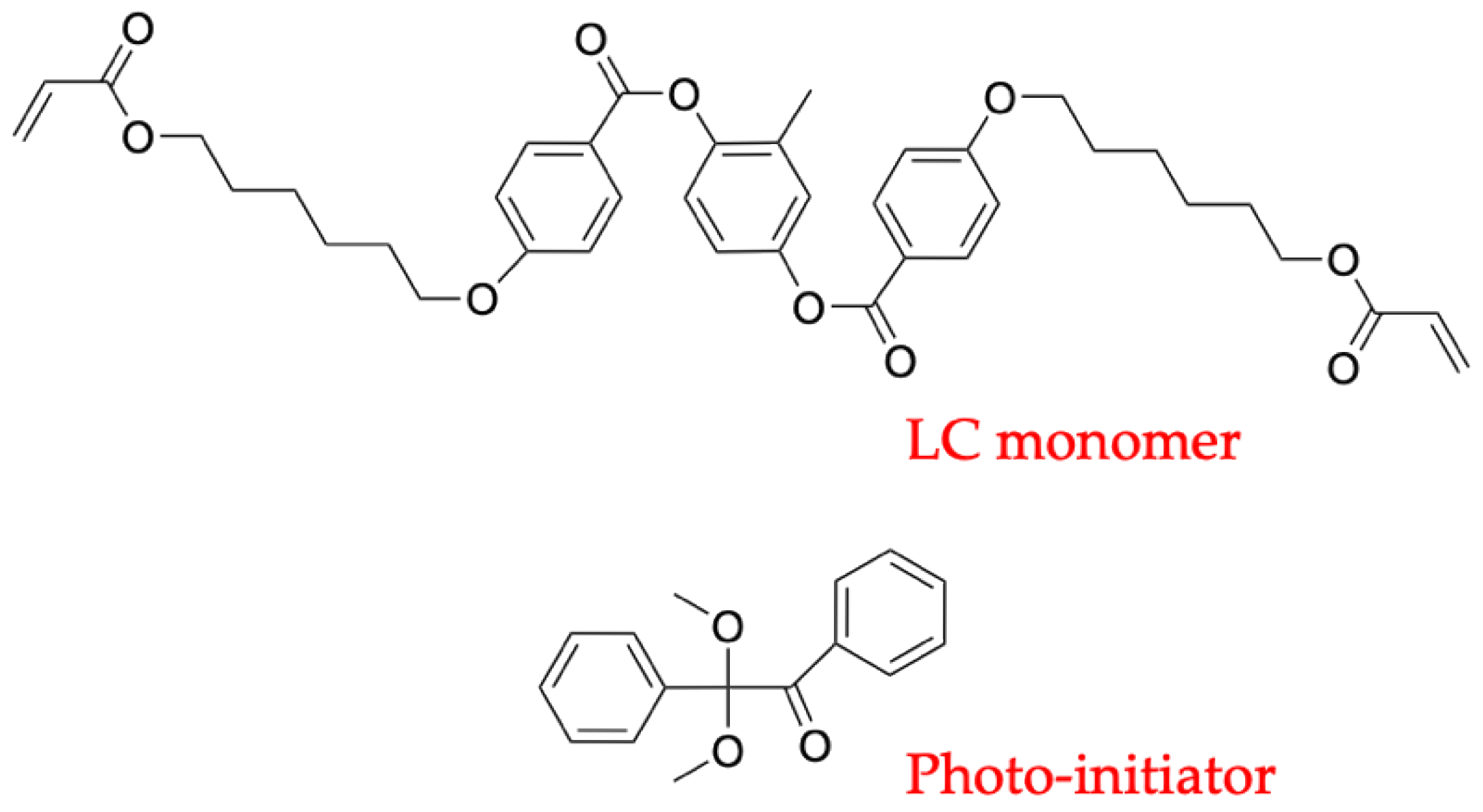
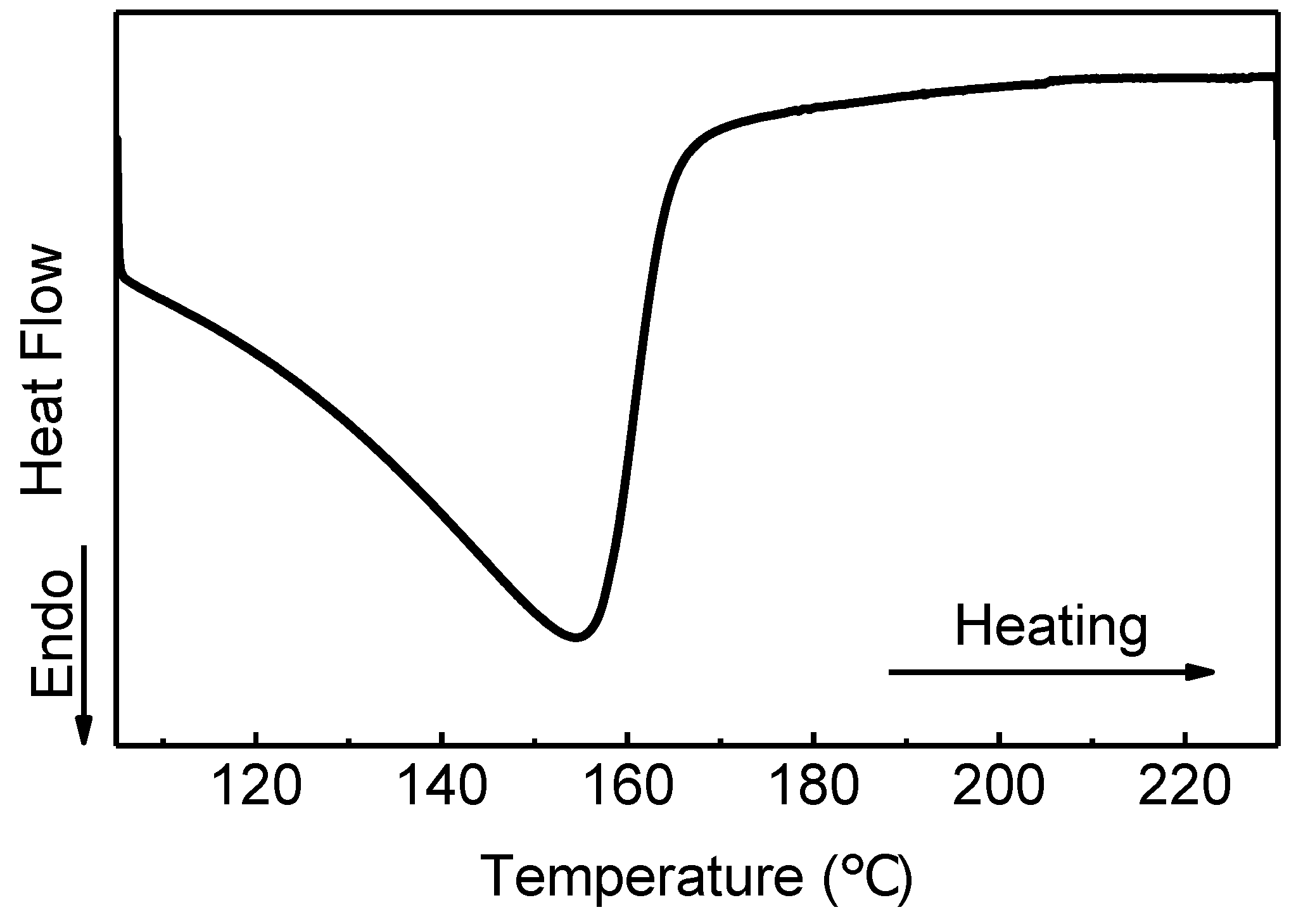

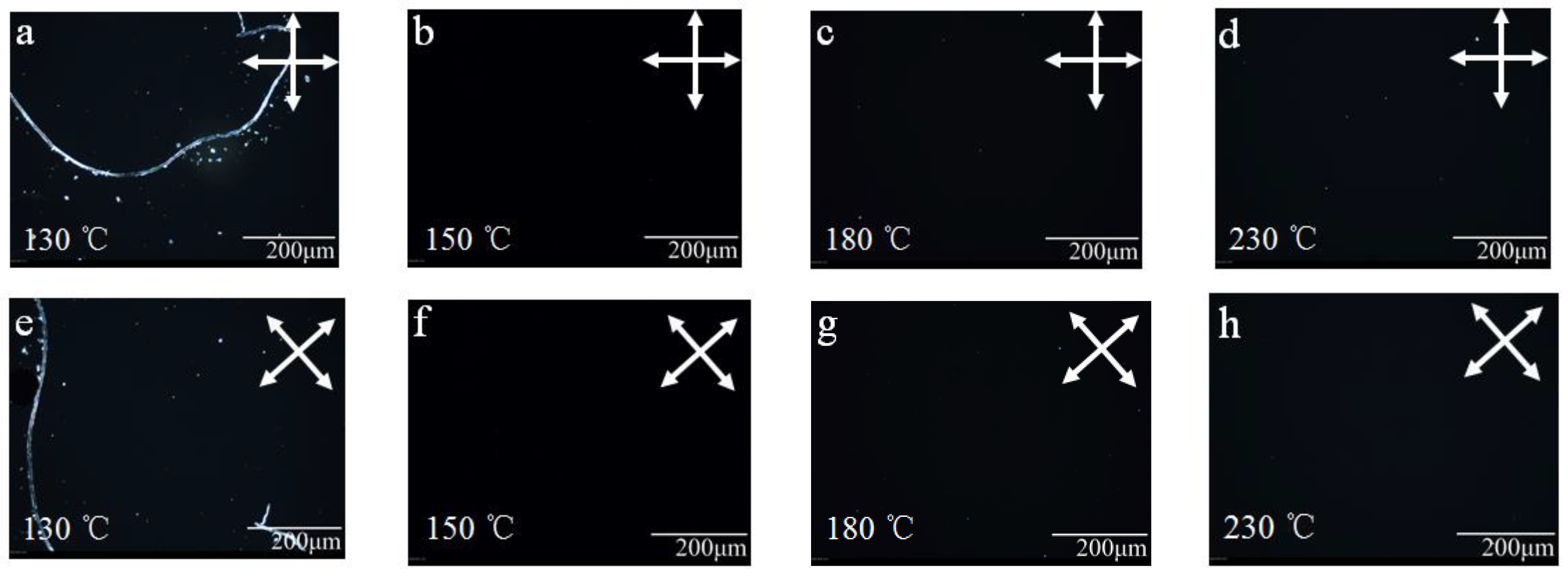
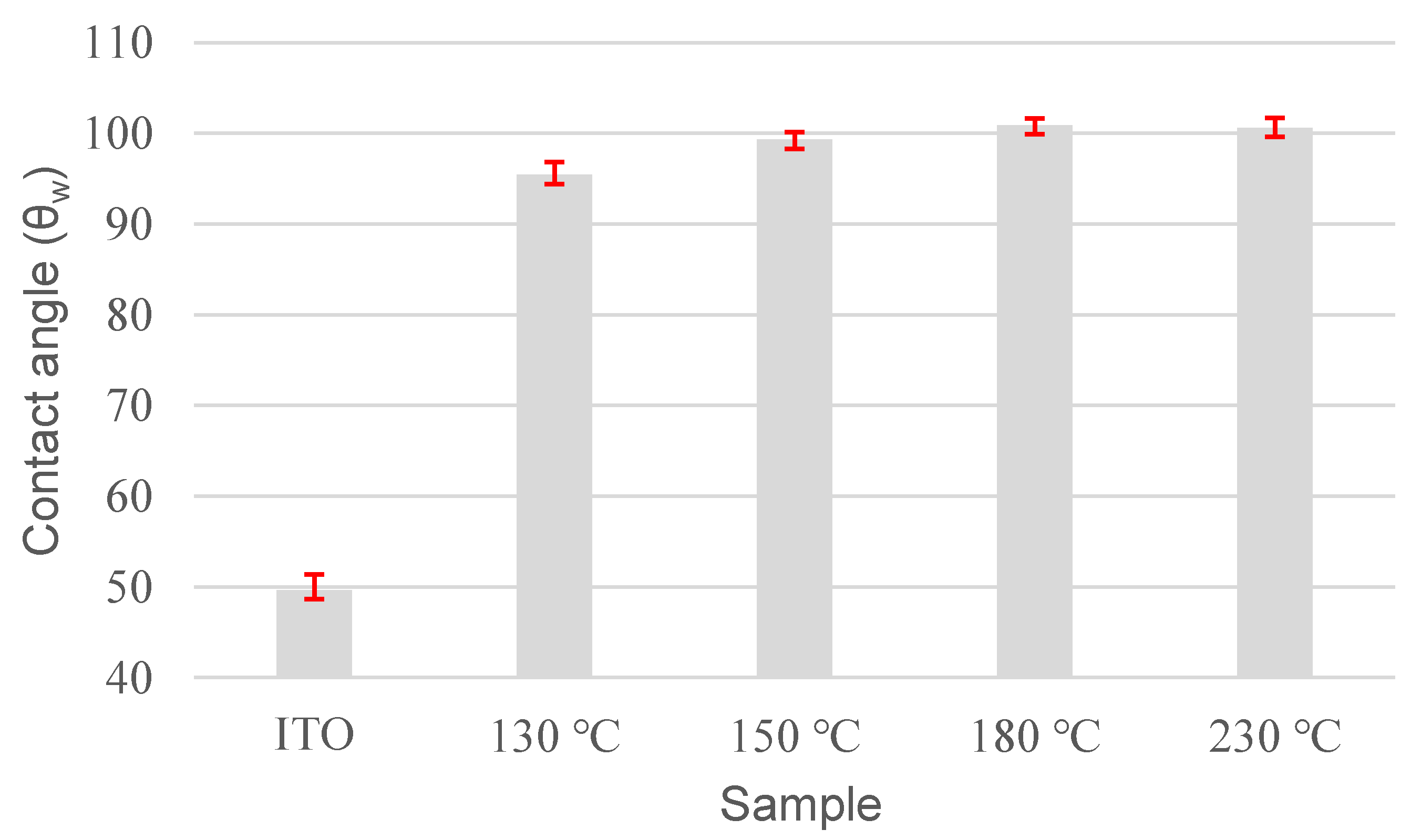
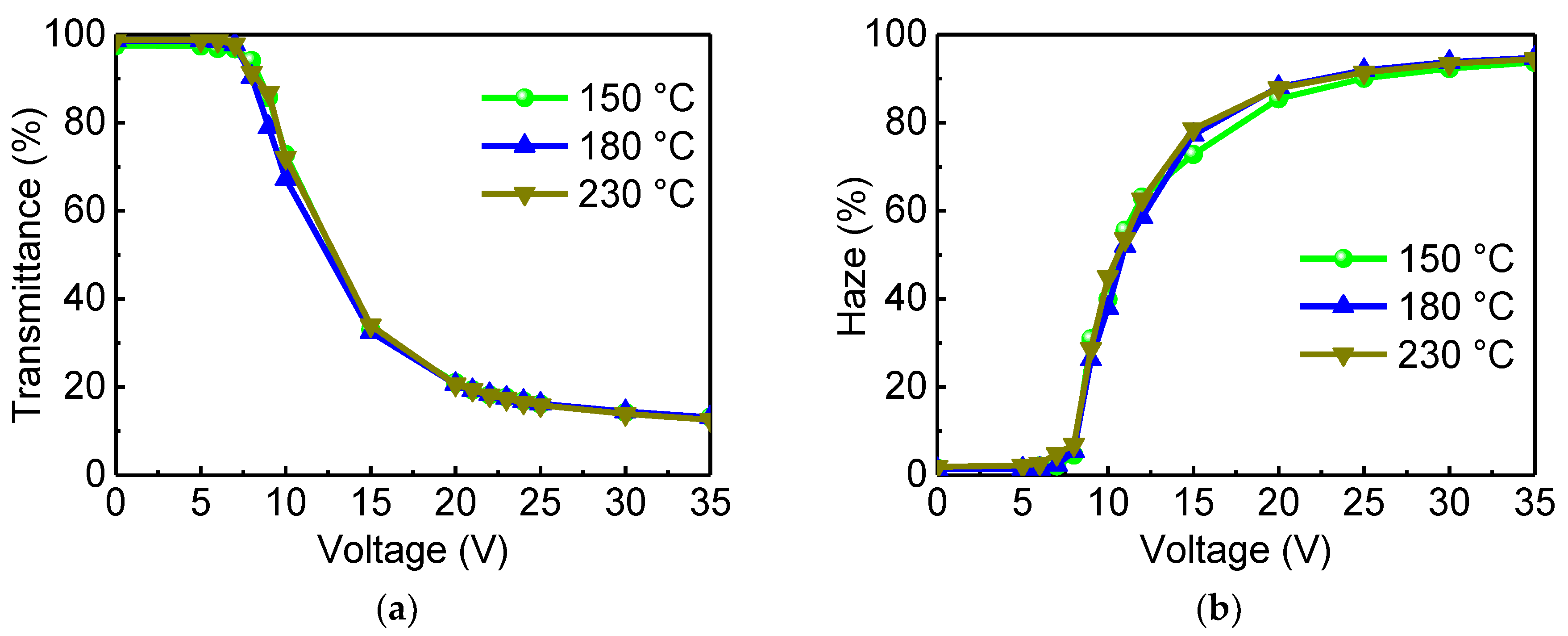
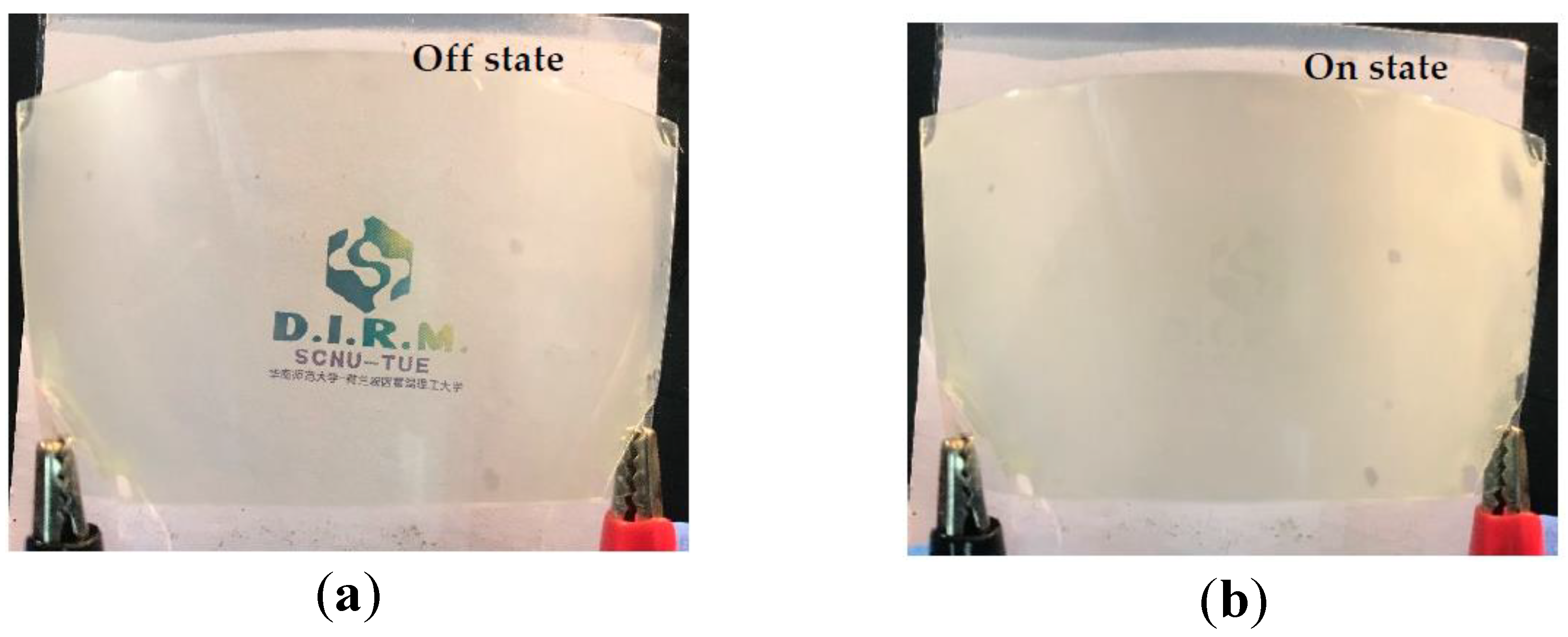
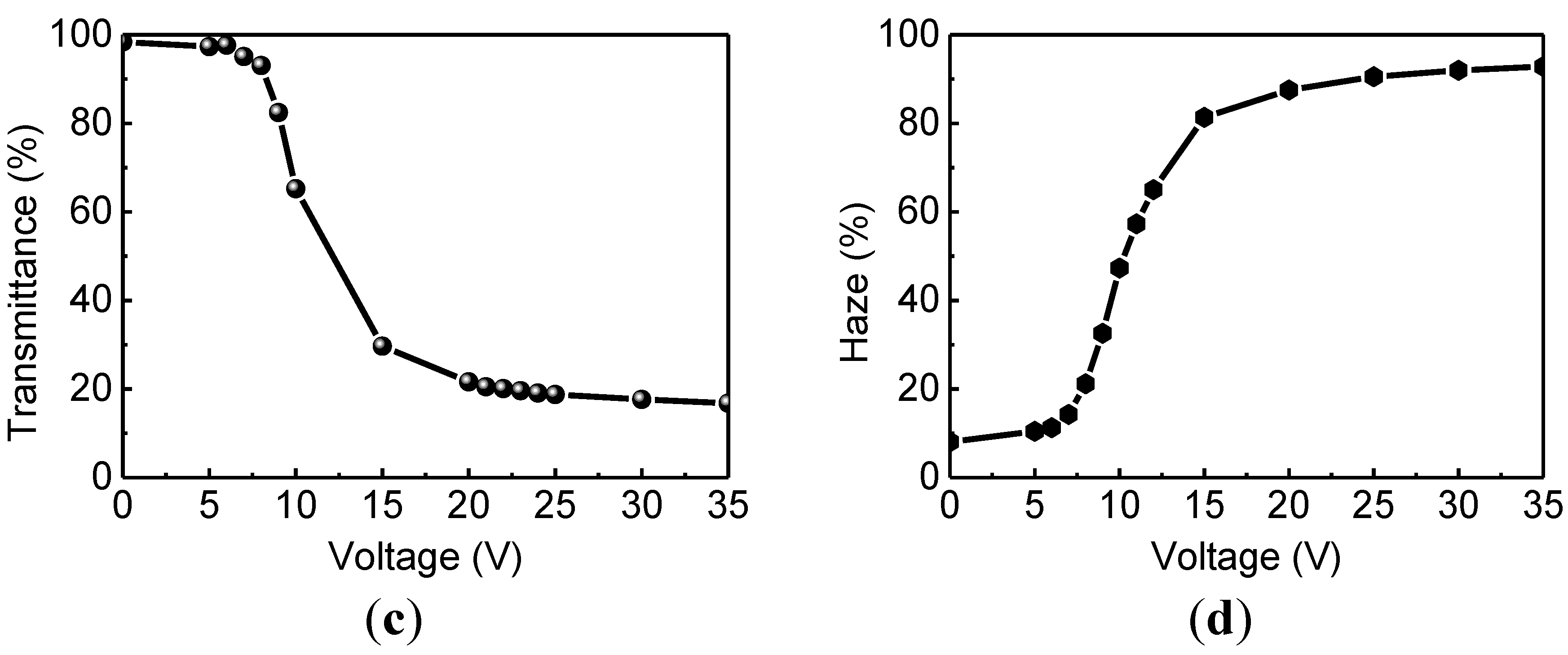
| Temperature (°C) | 130 | 150 | 180 | 230 |
|---|---|---|---|---|
| Pretilt angle (°) | 89.5 ± 0.02 | 89.8 ± 0.04 | 89.9 ± 0.02 | 89.8 ± 0.02 |
| Temperature (°C) | 130 | 150 | 180 | 230 |
|---|---|---|---|---|
| RMS (nm) | 3.8 ± 0.34 | 3.6 ± 0.47 | 3.4 ± 0.28 | 3.0 ± 0.45 |
© 2019 by the authors. Licensee MDPI, Basel, Switzerland. This article is an open access article distributed under the terms and conditions of the Creative Commons Attribution (CC BY) license (http://creativecommons.org/licenses/by/4.0/).
Share and Cite
Zhang, Y.; Wang, C.; Zhao, W.; Li, M.; Wang, X.; Yang, X.; Hu, X.; Yuan, D.; Yang, W.; Zhang, Y.; et al. Polymer Stabilized Liquid Crystal Smart Window with Flexible Substrates Based on Low-Temperature Treatment of Polyamide Acid Technology. Polymers 2019, 11, 1869. https://doi.org/10.3390/polym11111869
Zhang Y, Wang C, Zhao W, Li M, Wang X, Yang X, Hu X, Yuan D, Yang W, Zhang Y, et al. Polymer Stabilized Liquid Crystal Smart Window with Flexible Substrates Based on Low-Temperature Treatment of Polyamide Acid Technology. Polymers. 2019; 11(11):1869. https://doi.org/10.3390/polym11111869
Chicago/Turabian StyleZhang, Yang, Changrui Wang, Wei Zhao, Ming Li, Xiao Wang, Xiulan Yang, Xiaowen Hu, Dong Yuan, Weiping Yang, Yi Zhang, and et al. 2019. "Polymer Stabilized Liquid Crystal Smart Window with Flexible Substrates Based on Low-Temperature Treatment of Polyamide Acid Technology" Polymers 11, no. 11: 1869. https://doi.org/10.3390/polym11111869







